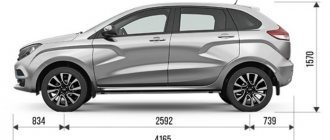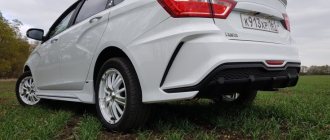Industrial progress has reached Russian production; AvtoVAZ never ceases to amaze with the uniqueness of the cars it produces, year after year creating more modern and more reliable cars. The new Lada Vesta Cross station wagon is one of the most interesting and original models of the domestic automobile industry. Even before it left the assembly line, AVTOVAZ’s flagship model SW Cross attracted attention with its appearance and design features and technical characteristics. In 2022, the assembly of the long-awaited Russian station wagon began and immediately aroused even greater interest and resonance.
Is it possible to increase Vesta's ground clearance, how?
A small re-equipment can help improve the cross-country ability of the Lada Vesta. In this case, the ground clearance of Vesta SW Cross needs to be increased only by the available amount. Intervention in the car's suspension will definitely lead to a change in its handling. Shock absorbers, drive shafts, their angles during operation, CV joints, calculation of loads when driving with obstacles are developed at a nominal ground clearance, and changing it will not be painless, because:
- The aerodynamic properties will change, drag, noise levels, and fuel consumption will increase.
- The center of gravity will rise, stability and controllability in corners will deteriorate. The load on the suspension will increase.
- Increasing the ground clearance by wheel size will cause the speedometer, odometer, ABS and ESP to work incorrectly.
- The service life of CV joints will decrease, the change from the calculated angle of operation, bending angles, turns, which will negatively affect the hinges, stabilizer bushings, and support bearings.
- Significant changes are also taking place in the operating mode of the suspension, which must adapt to new conditions. To achieve the maximum travel of the stock shock absorbers (front - 157 mm, rear - 169 mm), you will need to lengthen the rod. In the case of a critical load, the working amplitude increases and the stand may break out of the glass.
In order to minimize undesirable effects on the characteristics with increased clearance above the ground, it is necessary to lift it correctly, no more than 20-30 mm.
Increasing ground clearance in known ways makes adjustments to the efficiency of the suspension:
- Installation of larger wheels with higher profile tires. If you install 195/60/R16 instead of 195/55/R16 tires, this will increase the ground clearance by 5 mm. You can install larger wheels with the same tires, for example, 195/55/R17, which will increase the ground clearance by 12 mm. If you increase the wheels and tires, for example, 195/60/R17, then the lift of the car will be almost 2 cm. However, such actions will increase the load on the wheel bearings.
- The use of spacers for shock absorbers (metal, polyurethane, rubber) disrupts the toe angle of the wheels and reduces the service life of the CV joint.
- Replacing or increasing the rigidity of standard springs (by using intercoil attachments, buffers) sharply reduces their service life.
Spare parts, accessories, tuning elements and additional equipment are offered by Vesta Shop.
Option "bad road package"
When choosing a car, many buyers pay attention to its ground clearance, and this is natural, because the vehicle’s cross-country ability depends on the ground clearance, and this is an important advantage in our operating conditions. As a rule, jeeps, crossovers, and SUVs have high ground clearance.
As a rule, jeeps, crossovers, and SUVs have high ground clearance.
But many manufacturers, meeting the buyer who does not want to buy an expensive car, but at the same time dreams of becoming the owner of a car with high ground clearance, are introducing a special “package for bad roads” option for sedans and hatchbacks.
As a rule, this package provides:
- This model has increased ground clearance compared to its European counterpart, usually 3-5 cm;
- Reinforced chassis (levers – thickened polyhedral steel, reinforced springs, shock absorbers);
- Adaptation of the engine to our operating conditions (to our fuel);
- Factory installed engine protection;
- Other options depending on vehicle model.
But you need to take into account that the automaker indicates the ground clearance measured on an empty car; with passengers and cargo in the trunk, the ground clearance will decrease by a couple of centimeters, so many car owners, after purchasing a car, immediately try to increase this parameter using spacers, but this is another topic for discussion. And now about the main thing.
The Lada Vesta Cross sedan will receive off-road ground clearance
If we know almost everything about the Lada Vesta Sport sports sedan thanks to numerous leaks in the databases of Rosstandart, Rospatent and supplier catalogs, then the future of the cross-version of the sedan has still remained vague.
Raised sedans are generally rare on the market; in fact, there is only the large Volvo S90 Cross Country, which plays in a completely different league than VAZ products. Therefore, the appearance of a production version of the Lada Vesta Cross sedan was in question.
But, judging by the Vehicle Type Approval (VTA) that appeared in the Rosstandart database, the plant nevertheless decided to introduce such an unusual modification. The dimensions of the car coincide with the dimensions of the Lada Vesta SW Cross station wagon, with the exception of the height (1526 versus 1537 mm), which is due to the fact that the cross station wagon was initially certified with luggage rails on the roof. Thus, it turns out that the ground clearance of the Lada Vesta Cross sedan will exceed 200 mm: a completely off-road indicator!
AVTOVAZ has certified the cross-sedan with both engines that it offers for other versions of Vesta: a 1.6-liter with 106 hp. and 1.8-liter, 122 hp.
For the first time, Lada Vesta project manager Maxim Sarzhin announced that the car would become a production car in October last year. Thus, we can assume with a fair amount of confidence that the car will hit the market in the near future. Most likely, it will be produced in rather limited editions and only in an expensive configuration with heated second row of seats, two-tone interior design, 17-inch alloy wheels, etc.
- In July of this year, AVTOVAZ will begin production of the Lada XRAY Cross, which was shown as a concept in 2016.
- Another new product should be the updated Lada Granta. The plant has already launched prototypes for road testing.
What is the ground clearance of our Lada Vesta?
According to the manufacturer, Vesta’s ground clearance is at least 178mm.
The debate is still ongoing, and it began during its first presentation as a special Russian sedan with front-wheel drive. A good place to start is to understand what the definition of the term we are about to explore is.
Definition of the term
Vesta's ground clearance allows you not to be afraid of most curbs.
Ground clearance refers to the distance from the surface of the ground to the lowest protruding point of the car. The higher this indicator, the higher the vehicle’s cross-country ability and driving performance, for example, stability on the highway. What about this indicator for the subject of our consideration?
Lada Vesta is a special development, the brainchild of AvtoVAZ engineers who did their best. For faster, painless adaptation to Russian roads, the car turned out to be quite tall.
Standard indicators
According to the documents, its height above the road has the following indicators:
- 171 millimeters - to the engine sump;
- 144 millimeters - under the engine mudguards.
What does a full load include?
There is enough ground clearance to overcome fields.
The definition of full load means that we are talking about the maximum permissible weight of a loaded vehicle, including the driver, passengers, and transported cargo.
In our case, the difference between the total and curb weight will be as much as 400 kilograms for Vesta. If we talk about pure ground clearance, it will increase slightly if there is only a driver and a passenger sitting next to you in the car.
Ground clearance parameters of Lada Vesta without load
According to the documents, it turns out that ground clearance can increase significantly in this case, namely:
- 190 millimeters – to the engine sump;
- 230 millimeters – to the beginning of the front bumper overhang.
These indicators are especially pleasing, since now our Vesta doesn’t care about high edges or curbs. In practice, it is capable of overcoming fairly high obstacles if it is not particularly loaded. Measurement indicators indicate various positive aspects that can only benefit motorists.
Why do some controversial issues arise?
Ground clearance parameters depend on the wheel size.
The discrepancies may be caused by another factor. Ideally, 171 millimeters, even at maximum load, can be achieved when Vesta is shod with 16-inch wheels. At size fifteen, this figure will be lowered to 165 and 138 millimeters, respectively, to the engine mudguard.
Lada Vesta is not inferior to some of its foreign counterparts. We'll talk about this feature a little later. Now is the time to analyze the domestic market. Let's take a look and compare the ground clearance with other AvtoVAZ models.
Additional measurements in other places
Vesta's clearance to the lever.
With a clearance to the oil pan of 171 millimeters, the distance from the ground to the nearest element of the exhaust system will be about 187 millimeters.
Ground clearance to mudguard 165 mm.
This indicator significantly exceeds any other. This means that the muffler doesn’t care about even large obstacles. The car's off-road properties are at a decent level.
↑ clearance parameters
Above were the ground clearance parameters for the Lada Vesta when loading. As for an empty car, its indicator will be from 171 to 178 mm. There may be higher rates. In general, the manufacturers made sure that the sedan was quite “tall”. Otherwise, it will simply cling to the road with its bottom, which no driver will like. You can measure the distance not only to the crankcase or mudguard. For example, the clearance to the muffler is 18.7 cm.
Lada Vesta Cross - ground clearance
Industrial progress has reached Russian production; AvtoVAZ never ceases to amaze with the uniqueness of the cars it produces, year after year creating more modern and more reliable cars. The new Lada Vesta Cross station wagon is one of the most interesting and original models of the domestic automobile industry. Even before it left the assembly line, AVTOVAZ’s flagship model SW Cross attracted attention with its appearance and design features and technical characteristics. In 2022, the assembly of the long-awaited Russian station wagon began and immediately aroused even greater interest and resonance.
What is the ground clearance of the Lada Vesta St. Cross?
The clearance of Vesta Cross is truly outstanding, it is 203 mm.
Other car sizes:
The ground clearance allows it to compete with almost all modern crossovers of various brands and modifications.
Ground clearance comparison with competitors
The main competitors of Vesta SW Cross are objectively considered to be Lada Largus, KIA Rio X-Line, as well as the initial versions of Renault DUSTER and Hyundai Creta with front-wheel drive. However, the Lada Vesta Cross is not the last among them in terms of ground clearance. So for Largus the ground clearance is 145 mm, for Rio X-Line it is 170 mm, for Renault DUSTER it is 210 mm, and for Hyundai Creta this value is 190 mm. Thus, we can conclude that only the Renault DUSTER SUV can compete in terms of ground clearance, but we should not forget that the design features of the Lada Vesta Cross and the foresight of domestic developers did not easily make it possible to yield to a competitor in this area.
What is the Vesta Cross capable of off-road?
The Lada Vesta Cross feels confident both on a flat road and on a country road or even off-road. If you like to have an active holiday while driving a car on minor off-road conditions, the AVTOVAZ flagship is ideal for you. “SW Cross” is equipped with such off-road attributes as a protective plastic body kit and increased ground clearance. A protective black plastic body kit reliably protects the paintwork from chips and scratches, and the increased clearance allows you to confidently overcome obstacles on rough terrain.
Let's add to this attributes a powerful and economical engine, an energy-intensive suspension, and from ordinary driving on rough terrain, your trip turns into easy, pleasant and comfortable. The Lada Vesta Cross is also equipped with such options as cruise control and directional stability system, which will help the driver cover tens of thousands of kilometers without feeling tired or inconvenient.
Is it possible to increase the ground clearance of Vesta SW Cross?
Returning to the mention of the only competitor of the Vesta Cross station wagon in terms of ground clearance - Renault Duster, whose ground clearance turned out to be the highest, I would like to note that for drivers for whom the clearance of the Vesta SW Cross station wagon is not practical enough, they have a real opportunity to raise it height. In order to do this, it is necessary to make a number of modifications.
Increasing the ground clearance at the rear can be achieved by installing metal spacers under the strut support. To carry out such manipulations, you do not need to be a specialist in the field of mechanical engineering; any driver will be able to do this task and will take only 15-20 minutes. As a result of this modification, the rear clearance of the Lada Vesta Cross can be increased by 2-3 centimeters. You can do the same with the front part; this procedure will require the same algorithm of actions from you; the ride height will increase after installing the front strut support spacer.
↑ standard ground clearance indicators
If you look at the documents, you can easily understand what ground clearance the Lada Vesta has. It is believed that the distance from the engine crankcase to the ground is 171 mm. If you look at the height from the engine mudguard, the ground clearance will be 144 mm. These measurements were taken on 16-inch wheels. If the car has tires of a different size, then the ground clearance will change. For example, if 15-inch wheels are installed, the distance will be 165 mm to the crankcase and 138 mm to the mudguard.
How to increase car clearance, photos, videos
Ground clearance for a Russian car enthusiast is one of the most important characteristics.
The condition of our roads is often such that increasing the ground clearance is a matter of necessity rather than the personal wishes of the car owner.
Preparation
- Raising the body a few centimeters will not only save the bottom of the car, but will also, in fact, return the car to the position it occupied when it first came off the assembly line.
- Don’t be surprised, this is true, but this only applies to cars with high mileage and soft suspension, the springs of which have sagged quite a bit, especially after use on bad roads.
- Before you start increasing the ground clearance, you need to carry out a preliminary check: measure the actual ground clearance, as it may differ from that indicated in the car’s passport.
- Then you need to decide exactly how much it costs to increase the skylight height.
- In this case, you need to take into account several more parameters of the car: approach angles and longitudinal cross-country ability.
Basic methods
There are several ways to increase clearance. The main difference between them is their cost.
The most economical and simple options:
- changing wheels and tires to a larger size;
- installation of spacers;
- replacing springs and shock absorbers.
Features of each method
- Tires.
- If you decide to change to larger wheels, you should take into account the manufacturer's recommendations to avoid premature tire wear.
- Tires whose installation is not provided by the manufacturer may touch the arches when turning.
- Also, the larger the wheels, the higher the fuel consumption, the faster the wear of bearings, struts, etc.
- Spacers.
- They are installed between the springs and the body, making changes to the chassis of the car, and, therefore, violating the parameters set when the car was released.
- This may affect the performance of the suspension and may even become unsafe.
Spacers are made of aluminum, plastic and polyurethane.
Aluminum ones will last longer than plastic ones, and even more so polyurethane ones.
Spacers also differ in the place in which they are installed, that is, on the rear or front suspension, this is reflected in their markings.
There are spacers and interturn spacers, they are placed between the coils of the spring.
They are also made from various materials. These spacers increase suspension stiffness and reduce roll when cornering.
- Installing such additional elements increases ground clearance and prevents the car from sagging at the rear under heavy load.
- But at the same time, the operation of the suspension will change, the risk of its breakdown will increase, and vibration will increase.
- In addition to these, there is another type of spacers (“houses”) that are installed between the lower shock absorber mount and the rear beam.
- Using holes in their design, you can adjust the clearance height.
After installing such a part, additional adjustment of the front wheels, brake force regulator, headlights, etc. will be required.
Read on the topic: Lowering a car's suspension.
Shock absorbers and springs
- Replacing shock absorbers and springs with those not included in the design of the car brand is the most expensive way to increase ground clearance.
- Springs are installed with a larger number of turns, and shock absorbers with a longer stroke.
- In fact, this is already a full-fledged car tuning.
The disadvantages of such a change may be increased vibration, increased suspension stiffness, etc. But such a design will last longer than spacers.
Air suspension
The most expensive way is to install an air suspension.
To do this, you need to purchase air bags (for the front and rear suspension), a compressor, a receiver and a control device.
This suspension allows you to change the ground clearance depending on the condition of the road and the speed of the car (i.e., at increased speeds, a lower ground clearance is set, and for driving on uneven surfaces, an increased one).
Air suspension is expensive, difficult to install and has a short service life.
POPULAR WITH READERS: Choosing the type of shock absorbers for a car
We have recommended several basic ways to increase your car's ground clearance, and it's up to you to decide which one to use.
Technical characteristics of LADA Vesta - body, engine, transmission
The technical characteristics of the LADA Vesta are comparable to similar cars of this class, and here Russian manufacturers decided not to stand out - after all, we are talking about a budget model, so if there are additional modifications, they will be included in the category of a limited series “limited edition”.
Characteristics of the body and transmission of LADA Vesta
The body of the LADA Vesta is much more spacious than its classmates, because its dimensions are located outside the standard B class size classification. It is for this reason that Lada Vesta is classified as subclass B+.
| Name | Class | Length | Width |
| Extra small | A | up to 3.6m | up to 1.6m |
| Small | B | 3.6 – 4.2m | 1.5 – 1.7m |
| Small medium | C | 4.2 – 4.4m | 1.6 – 1.75m |
At the same time, the car is perfectly adapted for the Russian consumer - it has an increased ground clearance of up to 171 mm when fully loaded and a small turning radius of only 5.2 m. Good controllability and responsiveness of the steering wheel are ensured by new characteristics and the layout of the car's transmission - independent front suspension with classic McPherson struts and semi-independent rear suspension on an elastic transverse beam with spaced springs and shock absorbers. As a new feature, the Lada Vesta uses a lower steering rack, which will further increase the information content of the steering wheel. Disc brakes at the front and drum brakes at the rear will be equipped with modern ABS and ESP systems.
Characteristics of the LADA Vesta engine
The Lada Vesta engine line includes three modifications of 1.6-liter power units: 11189 (8-valve, 87 hp), 21129 (16-valve, 106 hp) and HR16 (16-valve ., 114 hp). Moreover, the latest option was developed jointly by members of the Renault-Nissan alliance. It is assumed that an automatic transmission will only be available on the 106 hp engine, although in the future it is possible to expand the available variations. All engines comply with EURO 5 environmental standards and will be actively used in export deliveries of LADA Vesta abroad. Preliminary tests pegged the car's top speed at 185 km/h, with a 0-100 km/h time of just 10.3 seconds, which is pretty good for consumption of 6.9 l/100 km.
In general, the technical characteristics of the Lada Vesta meet the requirements for the car and are designed to provide driving pleasure to an unpretentious driver. I will warn critics against making malicious remarks, the LADA Vesta is a budget car, and you don’t need to demand Ferrari characteristics from it.
| Characteristic | Sedan | Hatchback |
| Curb weight, kg | 1190 | 1150 |
| Length, mm | 4410 | 4250 |
| Width, mm | 1764 | |
| Height, mm | 1497 | |
| Wheelbase, mm | 2635 | |
| Front/rear axle track, mm | 1510 | |
| Turning radius, m | 5,2 | |
| Ground clearance (at full load), mm | 171 mm | |
| Aerodynamic factor, m2 | 0,82 | 0,85 |
| Engines 1.6 l | 11189 (8-valve, 87 hp) 21129 (16-valve, 106 hp) HR16 (16-valve, 114 hp) | |
| Fuel consumption in combined cycle, l | 6,9 | |
| Maximum speed, km/h | 185 | |
| Acceleration time to 100 km/h, sec | 10,3 |
How much clearance does the Lada Vesta have?
What kind of oil to pour into the Lada Vesta engine
Vehicle characteristics: The dimensions of the car are as follows: length - 3247, width - 1100, height - 1203 mm. The wheelbase is 2264 mm. Ground clearance 137 mm. The car is equipped with a hybrid power unit. The 4-cylinder engine is equipped with a system that provides engine power output. There are 4 valves per cylinder. The diameter of one cylinder is 76 mm, the piston stroke is 70 mm. The engine crankshaft accelerates to 7000 rpm. Maximum torque is maintained up to 4000 rpm.
Category: Repair instructions
Posted by admin: at the request of Hamlet
Views: 2264
Watch the VIDEO about the clearance of the Lada Vesta.
Criticism of a car owner named Josaphat: + Handling. + Equipment (Comfort). Heated seats, airbags, heated windows, power windows, etc., etc. + Interior (and the appearance of plastic, and space, and the design of the dashboard, and upholstery fabric, and all sorts of goodies such as two sockets with cup holders, etc.) + Ergonomics front seats + Standard sound (though, in comparison with Renault and VAZ) + Appearance + I can’t say anything objectively about sound insulation. Well, not really. But what to compare with? I compare it with Matis, with the eight .. —) So, for me it’s excellent.+ The steering wheel is 10 out of 10. Many people don’t like it. I want something more extreme. For me, such a plus is the obedient, gentle steering wheel. + Possibility of selecting modes: eco, sport. In sports - a beast! I don’t use it, it’s still early) + The machine is good. Maybe he hangs up a little, thinks, but only in IVF mode. I respect thinkers + Trunk. Not small. And it opens without harming a lady’s manicure (this is a woman’s review! :-))+ The glass washer tank is gigantic! Just right for our roads. In general, there is beauty under the hood, of course!+ The suspension is just what the doctor ordered (for me). Not hard, not soft, but just like that)
Original title: Apa lumen Lada Vesta
Release date: 05/22/2015
Duration: 4:26
Quality: HD
Laughter in the topic: You chase two hares, YOU Catch BOTH, EVERYONE APPLAUSES IN DECISION, THE LION WALKS UP AND SHAKES HAND, THE HARRIES WATCH WITH RESPECT, TAKE PHOTOGRAPHS
Safety
Whatever method of increasing the ground clearance on the VAZ 2110 you choose (if you need it, of course), remember that safety comes first. You want to get a car that will be more stable on the road, and not ready to roll over every minute even on a small obstacle?
Therefore, be sure to adjust the suspension to increase its elasticity. Swap out the regular tires on your car for low-profile tires. To ensure this, also install additional stabilizers.
If you find an error, please select a piece of text and press Ctrl+Enter.
Often, even a new car, with a fully or sometimes partially loaded trunk, hits the wheel arch liners with its rear wheels. You can get rid of this trouble, and at the same time increase ground clearance, by installing spacers between the lower ends of the rear shock absorbers and the eyes of the rear suspension beam.
We chose spacers that allow the rear of the car to be raised to three different positions.
When lifting the rear of the car, three important parameters change: the position of the rear brake pressure regulator, the direction of the light beams of the headlights and the caster angle of the front wheels.
The first two parameters can be adjusted independently. Castor decreases when the rear is raised, affecting the stability and controllability of the car.
For a vehicle in running order and with a payload of 320 kg (4 people) in the cabin and 40 kg of cargo in the trunk, the wheel alignment angles must be within the following limits:
caster angle
Vehicle wheel alignment angles in running order
(without driver, passengers and cargo)
caster angle
To install the spacers, we hang up the rear of the car.
1. Using a 19mm wrench, unscrew the nut of the shock absorber lower mounting bolt, holding the bolt from turning with a head of the same size
2. ...and remove the bolt.
Similarly, disconnect the lower mount of the second shock absorber.
3. On one side of the spacer, the distance shown in the photo is greater than on the other. With this side we orient the spacer towards the longitudinal axis of the car.
Please note that the spacers are mirror symmetrical and can be installed on both the right and left sides of the car
4. For proper installation of the spacer, it is necessary that the line passing through the centers of the holes for fastening the spacer to the beam and the lower end of the shock absorber is close to vertical and coincides with the longitudinal axis of the shock absorber.
Therefore, when installing the selected spacer on the right side of the car, only one hole can be used to attach the shock absorber.
5. If this option does not suit you, we place this spacer on the left side.
In this case, you can use one of the other two holes to mount the shock absorber.
We install the spacer on the beam eyes.
6. Place a spacer between the beam eyes and insert a bolt.
Place a nut on the bolt and tighten it to a torque of 70–85 Nm (7.0 -8.5 kgf∙m).
In this position of the spacers, the rear of the car can be raised to the maximum or minimum amount.
We chose the bottom hole
7. Insert the bolt into the holes of the spacer and into the shock absorber bushing.
What is the 203 mm ground clearance of the Lada Vesta SV Cross suitable for?
So, 203 mm - what is it? This is a ground clearance that in most cases will be comfortable for different types of drivers. Yes, the ground clearance of the Lada Vesta Cross SV is not suitable for real off-road conditions, but it is quite suitable for rough terrain.
The Lada Vesta SV Cross was conceived as an all-terrain station wagon, but not the entire concept of the car speaks about this. Firstly, there is only front-wheel drive, which has no chance off-road. Secondly, Vesta Cross SV does not have any off-road “assistants” such as locks and anti-bux. Thirdly, the standard wheels on the Vesta SV Cross are, in principle, not for driving on off-road routes. Agree, 205/50 R17 tires are generally out of place here. These are generally ordinary low-profile tires. It was more appropriate to increase the profile while reducing the diameter of the disk. But, it is as it is.
Why then is Vesta Cross SV needed at all? Many journalists and experts have come to the conclusion that the ground clearance of the Lada Vesta SV Cross is ideal for city and highway driving and infrequent cross-country trips. And the dimensions of the Lada Vesta Cross SV are similar to the sedan version.
Lada Vesta ground clearance
Lada X Ray Cross
Lada Vesta is a Russian car that began production in September 2015. Its sales started two months after the start of production. AvtoVAZ carefully hid the technical characteristics of the car until the last moment. The manufacturer presented a raised sedan called Lada Vesta on September 24, 2015 with a video presentation of a test drive on the roads of Italy. Only after the presentation it became clear that a fairly significant player from a domestic manufacturer had appeared on the market, which in terms of price and quality could compete with many foreign car brands.
How does the car behave on the road?
Lada Vesta on the road The high clearance of the Lada Vesta will be appreciated by owners living in the provinces.
However, such ground clearance can play a negative role, significantly reducing the level of comfort and controllability. The creators skillfully approached the neutralization of possible disadvantages. They radically fine-tuned the steering, as a result of which the car behaves perfectly on the road surface. The high ground clearance of the Lada Vesta rationally fits into comfortable driving and does not cause any major complaints from vehicle owners. You need to remember that when choosing a machine, you should consider the place where you will use the purchase most.
Is it possible to reduce clearance
The desire to reduce the ground clearance of the Lada Vesta SV Cross is not entirely clear. This car is purchased for difficult driving conditions. The owner usually reduces the ground clearance of a Lada not to improve technical characteristics, but to satisfy his own ambitions and beautiful photos. A certain part of car enthusiasts have their own opinion about the beauty and brutal appearance of the vehicle. They prefer down-to-earth cars that literally drag their bellies along the asphalt.
They reduce the ground clearance in two ways: they cut the springs with their own hands or purchase shorter ones - Technospring -50 mm or -30 mm.
In the first case, the financial costs will be minimal, but you need to work, in the second you will have to spend money.
If stiffer lowering springs are installed, lowering the ride height has certain advantages:
- Handling and stability at high speed are improved by increasing suspension rigidity.
- Sharper steering and lack of roll allow you to take turns at higher speeds.
- The car does not “bite” during sudden braking or stopping.
- Reducing resistance reduces fuel consumption (up to 0.5 liters per 100 km).
What are the negative reviews associated with:
When driving over bumps and bumps, you will have to slow down, increase your vigilance, and be careful not to damage the front bumper and underbody. There is a risk of damage to the lower part of the door on the curb when opening it in a parking lot. Outside the city, on country roads, you will have to carefully choose a suitable route. In many areas of the lowered Lada Vesta, the passage may be completely closed. On a snowy road, the front bumper can turn into a snow bucket
Narrow arches will promote snow accumulation.
For some, a reduction is truly a measure that significantly improves technical characteristics and allows you to correct the manufacturer’s shortcomings. For others, the disadvantages that arise when reducing ground clearance are unacceptable.











